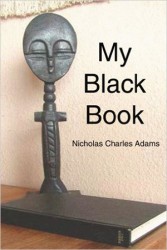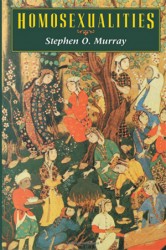 My Black Book
My Black Book
by Nicholas Charles Adams
Published by iUniverse
Published 2004
History (memoir)
173 pgs. • Find on Amazon.com
Reviewed by Stephen O. Murray
What follows is the text of a foreword I wrote for My Black Book that wasn’t used in it. Transforming it into a review, I need to add a bit of description. The book recalls (on the basis of the author’s journals) sexual encounters with black men: twenty from 1978–80, another seven from 2002–03. The first set is a mix of relationships of some duration and “tricks”; the second set mostly portrays single encounters. The stories are sexually graphic. I would say that there are not “about sex,” but about trying to understand some men, including the author, through sexual encounters (how they connected and disconnected in a more general sense than that of organs and orifices). The pleasures are most definitely “embodied,” the regrets are mostly not about what the bodies did or did not do.
Having encouraged the author to look at materials from his journals as the basis for a book and aimed him at a publisher with whom I have published, I am not at all an objective reviewer and agreed to write a foreword to put the book in the context of a larger discourse on “erotic subjectivity.” Some people consider any sexually explicit writing as “pornography,” while some of those who like what they’re reading distinguish “erotica” (pant-inducing and, therefore, good) from “pornography” (to be sneered at). I think sexually explicit writing can also attempt to understand the self (the reader’s as well as the author’s) and the puzzles of other persons’ “beings in the world”—what motivates them, what their sexual behavior means to them, etc. Explicit representation of interracial sexual encounters and patterns of conduct are especially fraught…and quickly excoriated with (widely varying!) standards of political correctness. I would hazard the guess that there is so little writing by white gay men about encounters (sexual or other kinds) with black men in part because of fear of being labeled a racist. (There is writing by black gay men focused on sexual relations and relationships with white men. In gay black fiction, as Adams notes, the white lover is often killed off in the course of the story.)
The author’s own explanation of his project is as follows:
I do not consider myself a spokesman for white men who have sex with black men. And I have no particular interest in providing “balance” to the black gay male writing about interracial sex with an account of one gay white man’s experience.
I consider that how we connect and how we fail to connect is interesting and worth trying to understand. In this book I write about what I observed about myself in sexual congress with a series of black male sexual partners. There is evidence in what they said (or cried out!) of what they sought, what they liked, and some of what they didn’t like in our encounters. Insofar as I was observing myself, I more explicitly questioned what I was doing and what I wanted. Put into the language of epidemiology, the risk factor propelling me was wanting love. It is, I think, also the reason that writers write. Writing what will repel and scandalize many is an odd way to seek love, I know. But people, including writers, want to be loved for who they are (that is, who they believe they are), not for their skills at dissimulation.
The Unused Foreword
 For a quarter of a century, I have been writing about gay identity and community, and about various roles around the world and across millennia that have involved same-sex sex. One of my chief frustrations with the historical and ethnographic literatures is the paucity of detailed data on same-sex desires. I would very much love to compare systematic data about the subjectivities of those engaged in same-sex sex across space and time, but these data are nearly non-existent, so that my comparative history of homosexual relations (culminating in the book Homosexualities) has had to rely heavily on what those not engaging in same-sex sex wrote about the doings of others. Carefully contextualized and fine-grained data about individual meanings and desires are lacking for most times and places.
For a quarter of a century, I have been writing about gay identity and community, and about various roles around the world and across millennia that have involved same-sex sex. One of my chief frustrations with the historical and ethnographic literatures is the paucity of detailed data on same-sex desires. I would very much love to compare systematic data about the subjectivities of those engaged in same-sex sex across space and time, but these data are nearly non-existent, so that my comparative history of homosexual relations (culminating in the book Homosexualities) has had to rely heavily on what those not engaging in same-sex sex wrote about the doings of others. Carefully contextualized and fine-grained data about individual meanings and desires are lacking for most times and places.
I have sought to encourage honest accounts of male-male sexual desire, including extended quotations in some of my own analyses and connecting some authors of book-length erotic memoirs with publishers (before this one, Sex, Longing and Not Belonging (for which I wrote an afterword) and Flipping, a flamboyant roman à clef from a gay Filipino American (for which I wrote a cover blurb). The late University of Houston sociologist Bill Simon especially inspired me to try to get at individual meanings of recurrent desires and patterns of sexual conduct in the complexity of the postmodernist present. “As never before, more than finding the origins of sexuality in the history of their culture, we must seek these origins in the varied histories of individuals,” he convincingly wrote.
Nick and the authors of the other two books about sexual conduct that I have facilitated know that writing explicitly about interracial homosexual sex makes many people uneasy — and not just the Jesse Helmeses of this world, but also many lesbian and gay respectability-cravers who are aesthetically or morally offended by male “promiscuity” and/or who want to keep such goings-on secret from straight folks. Moreover, there are many who presume that interracial sex must be exploitative and that a series of race-crossing relationships must involve something pathological, whether the pathogen is objectification, low self-esteem, internalized racial self-hatred, or some other abstraction. Like Badruddin Khan and Ricardo Ramos, Nick has felt that he could be completely frank about variously forbidden, often “politically incorrect” desires only writing under a pseudonym.
Each of them analyzes as well as reports their behavior, and I do not want to pre-empt Nick’s emerging self-understanding by imposing my own analysis on those who have not read his account of his eroticized experiences with African American men. What I find most interesting is the basic continuity “across the life course” (more than two decades of it, any way) of what he (most/ultimately) wants, especially in that this is counterpoised to significant changes in his sexual behavior.
I have certainly winced more than a few times in reading these books (and other erotic memoirs, such as Wild Animals I Have Known). I think that Bertholt Brecht was probably right when he wrote “We’d all be humane, if we could.” Very often, alas, this is a very big “if.” People sometimes do not treat with respect and consideration even those who are providing them pleasure. I think that Nick tried to do so, though he honestly describes several instances of regretful pulling away—as well as some sexual relationships in which he was not treated well.
Mostly, though he celebrates the sexual connections across the American great divide of race that he made, varying in duration though the relationships were, during two particularly interesting epochs of modern American gay history, the pre-AIDS late-1970s and the post-everything years of the start of the third millennium.
Pros: Candor and wit
Cons: Difficult to maintain analytic distance
The Bottom Line: Not for those made uneasy by explicit writing about sex (and race).
Originally published on epinions 4 April 2004
©2004, 2016, Stephen O. Murray

